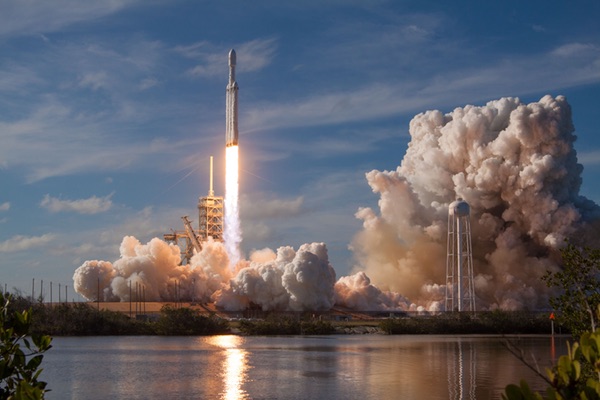Why couldn’t NASA do this?by Mark A. Wessels
|
| Why couldn’t NASA achieve these miracles? Why has it taken a company—funded in part by NASA, mind you—to pull this off? |
After the spectacle ended, I began to think. What was most impressive about the launch was not the enormous power of the vehicle—which was very impressive—or the car sent into space. It was the fact that much of the rocket came back to be used again and the enormous reduction in costs that this will afford. Commentators have already remarked that the cost of this launch is but a fraction of what similar launches have run. If SpaceX can sustain this level of success, we will very likely see a revolution in space travel.
Fifty years ago, we had the Saturn V, which still holds the record as the most powerful rocket ever successfully flown (13 times, to be exact). The Saturn came to an end, though, as people began to complain about how expensive it was. (It was expensive: in today’s money, each launch of the Apollo spacecraft to the Moon and back would cost about $1.5 billion.) No part of the Saturn V was reusable.
The Space Shuttle was supposed to solve the expensive problem of getting into space. The brilliant idea behind it was reusability. The shuttle would launch as a rocket, reenter, and land like an airplane, and then be readied for a new flight. But most importantly, the cost of each flight would be just a fraction of the cost of each payload.
The Shuttle was supposed to be a totally reusable system. But technical, economic, and political reality did not allow for this. Compromises were made. The amount of work that each shuttle needed for another launch was grossly underestimated. After each flight, many of the orbiter’s protective thermal tiles had to be replaced, an expensive task. The two solid rocket boosters had to be recovered from the sea and refurbished. The multimillion-dollar external fuel tanks were thrown away each time. Frequent launch delays were very costly. Plus, the shuttle had people onboard—its own unique and expensive problem. At the end of the shuttle program, in 2011, each flight had come to cost about $1 billion. In reality, the Shuttle became the most expensive means of getting into space.
SpaceX seems to have mastered the huge technical problem of successfully recovering the first stages of its rockets. Eight refurbished stages have been reused at least one time. This promises to yield significant reductions in the cost per pound of payload. SpaceX CEO Elon Musk is talking about payload figures as low as $1,000 per pound ($2,200 per kilogram); most space launches cost several times this amount.
Why couldn’t NASA achieve these miracles? Why has it taken a company—funded in part by NASA, mind you—to pull this off? I submit that political pressures have actually handicapped what NASA can now achieve.
At the beginning of the Space Race, NASA was in the business of taking risks. In the 1960s, each new flight pushed the envelope by going farther and faster than the previous one had. The brave men who sat atop gigantic rockets holding millions of pounds of explosive fuel were certainly aware that they were taking risks. This was necessary to achieve a singular goal—to be the first nation to reach the Moon—within just eight short years.
| If SpaceX can produce and fly the rockets at a fraction of the cost of a government program, then perhaps they should be in the rocket business, and NASA should be in the space exploration business. |
Now, NASA is in the business of risk aversion. This has become necessary for NASA’s political survival. Many observers have noted that when the government cut Apollo’s funding, NASA found itself in an existential battle: how to justify its continued existence. NASA had achieved Kennedy’s goal of landing a man on the Moon and bringing him back alive. Now what? The shuttle was NASA’s answer to that question. Then came the ISS, something to justify the shuttle itself. In order to keep the gravy coming, NASA was forced to make safe political choices. It couldn’t survive by bringing pie-in-the-sky plans to Congress.
That’s why the Constellation Program, the most recent plan to return America to the Moon, failed. It’s why the new Orion space capsule won’t carry astronauts until 2023, five years from now. It’s why the upcoming Space Launch System (SLS) has no clear mission. It’s why NASA couldn’t do what SpaceX did today.
Essentially, America now has two space programs. Ironically, funding for both largely comes one source: the American taxpayer. To date, SpaceX has received more than $4 billion in US government funding to pay for its ISS resupply flights. NASA has an annual budget of more than $19 billion, including millions we pay Russia to take our astronauts to and from the ISS.
Can we afford to continue this? I am not suggesting that we kill NASA in favor of SpaceX. Rather, perhaps the mission of NASA should be changed to bring back to risktaking. In the words of Dr. Robert Zubrin, president of The Mars Society and co-inventor of the Mars Direct plan, NASA “should take-on goals that are worthy of the risks of sending people into space.” If SpaceX can produce and fly the rockets at a fraction of the cost of a government program, then perhaps they should be in the rocket business, and NASA should be in the space exploration business, not the “politically safe” business.
I am a huge fan of the space program. I want to see it succeed. I want America to know once again the glory that it once knew in space flight. I believe that millions of other Americans feel the same way. Let us consider the stunning achievement that we witnessed, think about what we really want to achieve in space, and set about achieving those goals in the best possible way.
